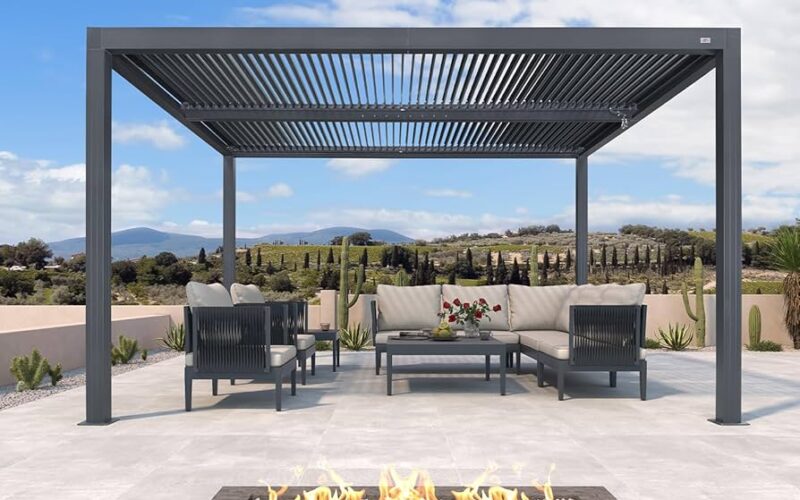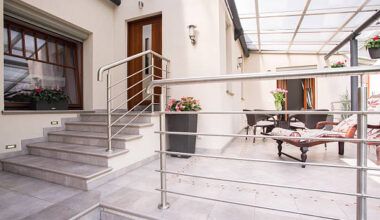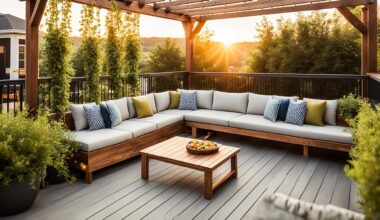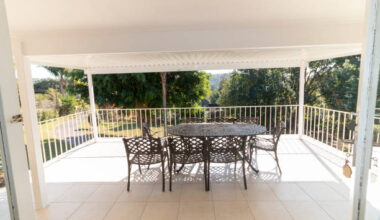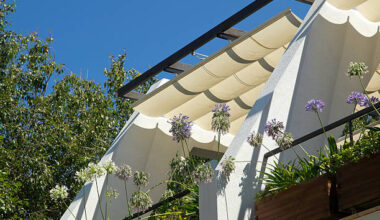Are you dreaming of creating a beautiful outdoor oasis in your backyard? A pergola can be the perfect addition to enhance your space and create a sense of freedom and relaxation. But when it comes to choosing the right support for your pergola, there are several factors to consider.
In this article, we will explore the importance of selecting large posts for pergola and how they contribute to its overall strength and stability. We will discuss the various materials available for pergola supports and their pros and cons.
Additionally, we will delve into considerations such as support size, shape, height, placement, anchoring techniques, design options, maintenance requirements, longevity, and cost considerations.
Whether you prefer a rustic wooden structure or a sleek modern design, understanding the different aspects of selecting suitable support for your pergola is essential. By making informed decisions about your pergola’s support system, you can ensure that it not only enhances the beauty of your outdoor space but also provides long-lasting durability and security for years to come.
Get ready to embark on this exciting journey of building your dream pergola with confidence!
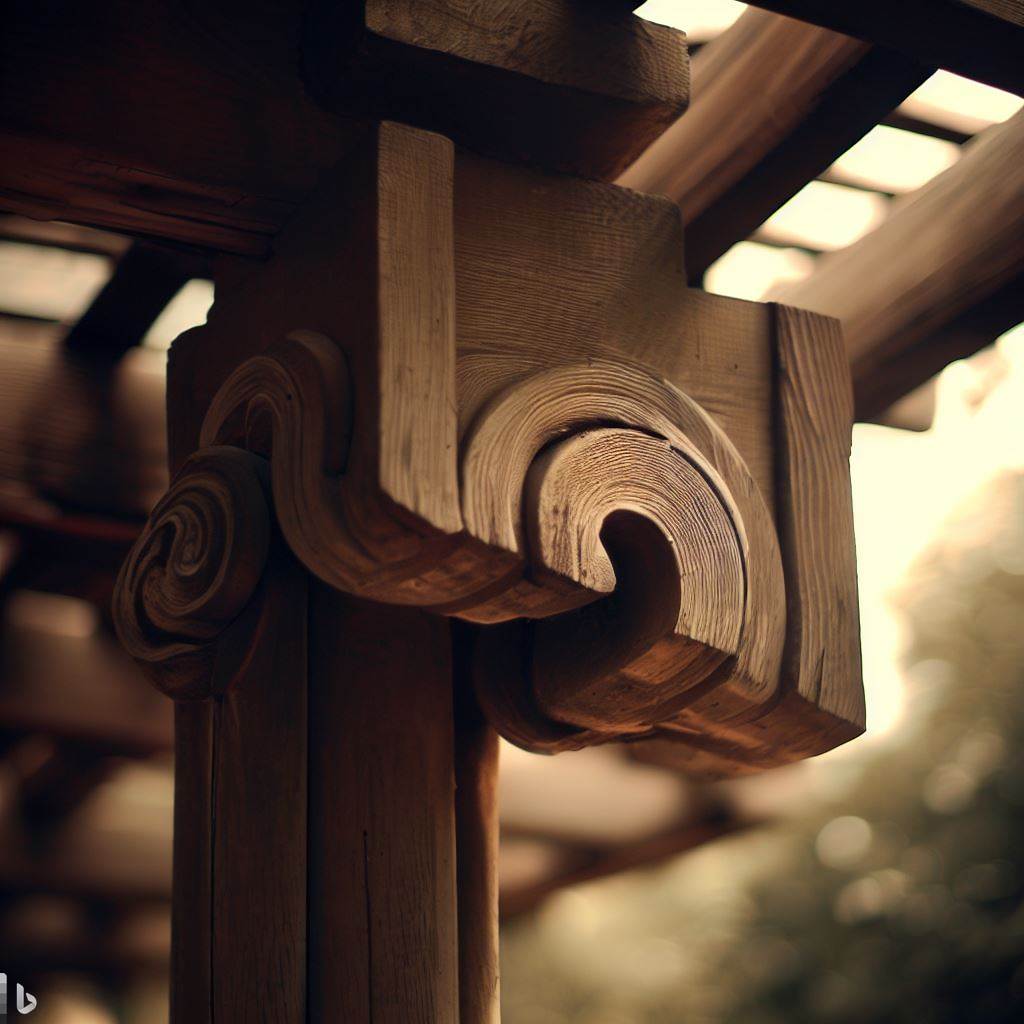
Key Takeaways
- The choice of pergola support materials includes wood, metal, and vinyl, each with their own advantages and disadvantages.
- Larger diameters and thicker posts provide more stability for the pergola structure.
- Concrete footings offer a solid foundation and prevent shifting or sinking of the pergola.
- Regular inspection, maintenance, and the use of durable materials like pressure-treated lumber or cedar wood are crucial for the longevity and appearance of the pergola.
Materials for Pergola Supports
Now, let’s talk about the materials you should consider for your pergola supports. When choosing the right support for your structure, it’s important to select a material that not only provides durability but also adds aesthetic appeal to your outdoor space.
One popular option is wood, which offers a natural and timeless look. Cedar and redwood are excellent choices due to their resistance to rot and insects. Another option is metal, such as steel or aluminum, which provides strength and stability while requiring less maintenance than wood.
If you prefer a modern or industrial style, metal supports can be an ideal choice. Additionally, vinyl is gaining popularity as it offers low maintenance and comes in various colors and styles. Consider these materials carefully as they will form the foundation of your pergola as we move on to considerations for support size and shape.
Considerations for Support Size and Shape
When considering the size and shape of your pergola supports, there are a few key points to keep in mind:
- First, consider the diameter and thickness of the posts you choose. Larger diameters and thicker posts will provide more stability for your structure.
- Second, decide whether you prefer square or round supports. Square supports can give a more modern look, while round supports offer a classic aesthetic.
- Finally, think about any decorative elements you may want to incorporate into your pergola supports, such as carvings or accents, to add a personal touch to your outdoor space.
Diameter and Thickness
Choosing the right diameter and thickness for your pergola posts is like finding the perfect balance between strength and aesthetics. The size of the posts directly impacts how sturdy your structure will be, so it’s important to choose wisely. Larger diameter posts provide more stability and support, but they can also look bulky and overpowering.
On the other hand, smaller diameter posts may look more elegant, but they might not be strong enough to withstand heavy winds or other weather conditions.
When it comes to thickness, thicker posts are generally stronger and more durable. However, keep in mind that thicker posts can also take up more space and obstruct views if you have a scenic backyard. Finding the right balance between diameter and thickness will ensure that your pergola is both structurally sound and visually appealing.
Now let’s discuss whether square or round support is better for your pergola design…
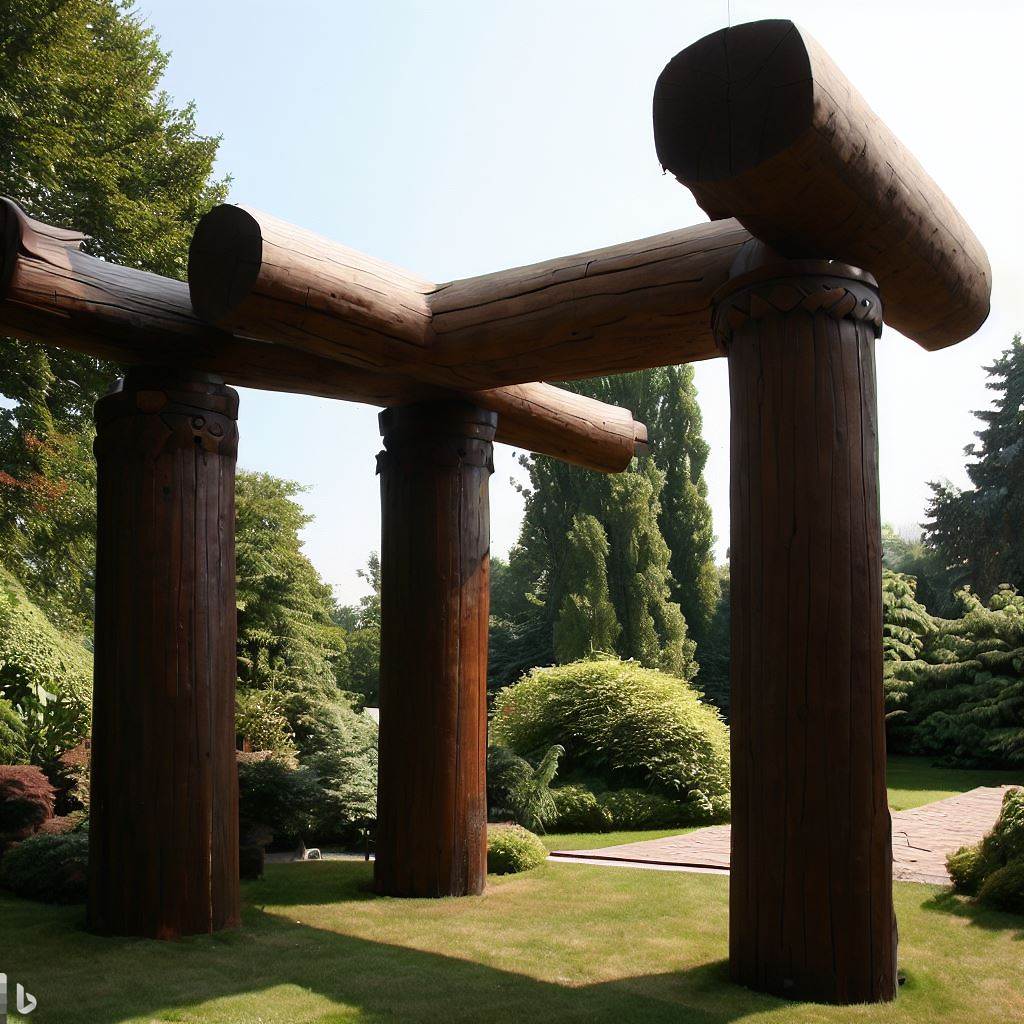
Square or Round
Imagine the impact on your pergola design if you choose wrongly between square or round support. The choice between these two shapes can greatly influence the overall aesthetic and functionality of your structure.
Square supports offer a more modern and sleek look, adding a touch of sophistication to your outdoor space. They also provide better stability, especially in areas with high wind or heavy snowfall.
On the other hand, round supports evoke a more traditional and rustic feel, perfect for those who prefer a cozy and inviting atmosphere. Round posts are also known for their durability and ability to withstand natural elements over time.
Whether you choose square or round support, both options can be enhanced with decorative elements such as intricate carvings or ornate caps to further personalize your pergola. Transitioning into the next section about ‘decorative elements,’ consider how these accents can truly elevate the style of your pergola while maintaining its structural integrity.
Decorative Elements
Adding decorative elements to your pergola can truly enhance its style and create a personalized outdoor space. There are various options you can consider to add that extra touch of elegance and charm.
One popular choice is incorporating ornamental brackets or corbels, which not only provide additional support but also serve as beautiful architectural accents. Another option is using lattice panels or screens to create a sense of privacy while adding a decorative element at the same time.
You could also opt for hanging baskets or climbing plants to add a natural and vibrant touch. Whatever decorative elements you choose, make sure they complement the overall design of your pergola. But what about the height and placement of pergola posts? Can they ensure stability and functionality without compromising aesthetics?
Height and Placement of Pergola Posts
To create a breathtaking outdoor oasis, envision yourself standing beneath the towering pergola posts, strategically placed to provide the perfect balance of shade and sunlight. When it comes to the height and placement of your pergola posts, there are a few key considerations to keep in mind.
First, think about the purpose of your pergola. Are you looking for a cozy seating area or a grand entrance? The height of your posts will depend on the overall scale and style you want to achieve.
Additionally, consider the surrounding landscape and any nearby structures. You want to ensure that your pergola doesn’t obstruct any views or clash with existing elements. By carefully choosing the height and placement of your pergola posts, you can create an inviting space that seamlessly integrates into its surroundings.
Now let’s explore how anchoring and stability play a crucial role in ensuring the longevity of your pergola structure.
Anchoring and Stability
When it comes to anchoring and stability for your pergola, there are a few key points to consider:
- Concrete Footings
Concrete footings are a solid foundation choice for your pergola structure, ensuring stability and longevity. They provide a sturdy base that can withstand various weather conditions and prevent the structure from shifting or sinking over time.
Here are some key benefits of using concrete footings for your pergola:
- Durability: Concrete footings offer unmatched durability, making them ideal for supporting large posts.
- Strength: They provide excellent load-bearing capacity, allowing your pergola to withstand heavy weights or strong winds.
- Versatility: Concrete footings can be customized to suit different soil types and site conditions, ensuring optimal support for your pergola.
- Longevity: With proper installation and maintenance, concrete footings can last for decades without requiring major repairs or replacements.
- Aesthetic appeal: While primarily functional, concrete footings can also be designed to complement the overall look of your pergola.
With a solid foundation in place, you can now move on to the next step of bracing and crossbeams to further enhance the stability of your pergola structure.
- Bracing and Crossbeams
Bracing is crucial because it helps prevent your pergola from swaying or leaning under heavy loads or strong winds. By strategically placing braces at key points along the structure, you can add extra support and reinforce its overall strength.
Crossbeams, on the other hand, provide horizontal stability to your pergola. They are typically positioned across the top of the posts and act as a framework for attaching rafters and purlins. This not only enhances the structural integrity but also adds visual appeal to your outdoor space.
With properly installed bracing and crossbeams, you can enjoy a sturdy and long-lasting pergola that will withstand various weather conditions, including wind and rain resistance in particular.
- Wind and Weather Resistance
To ensure the longevity of your outdoor space, it’s important to prioritize wind and weather resistance when designing your pergola. Strong winds and harsh weather conditions can take a toll on your structure if not properly addressed.
Start by choosing sturdy materials such as aluminum or steel for the frame, as they are known for their durability and ability to withstand strong gusts. Additionally, consider adding a roof cover that is resistant to UV rays and moisture, protecting both you and your pergola from the elements.
Don’t forget about anchoring your pergola securely to the ground using concrete footings or metal anchors to prevent it from being lifted or shifted during storms. By taking these measures, you can ensure that your pergola will stand tall against whatever nature throws its way.
Design and Aesthetics
When it comes to designing your pergola, one important factor to consider is the overall aesthetics. You want your structure to not only be functional but also visually appealing. Here are three key design elements to keep in mind:
- Material: Choose a material that complements the style of your home and outdoor space. Options include wood, vinyl, and metal, each with its own unique look.
- Color: Consider the color scheme of your backyard and choose a pergola color that blends well with the surroundings. Whether you prefer a natural wood tone or a bold painted finish, make sure it enhances the overall aesthetic appeal.
- Decorative Details: Add architectural details like decorative columns or lattice panels to enhance the visual interest of your pergola.
By carefully considering these design aspects, you can create a pergola that perfectly matches your taste and adds charm to your outdoor living area. Now let’s explore how proper maintenance and longevity play crucial roles in keeping your pergola looking its best over time.
Maintenance and Longevity
When it comes to the maintenance and longevity of your pergola, there are several key points to consider. First, you’ll want to choose materials that are durable and can withstand the elements. Look for options that are resistant to rot and insects, as these can significantly impact the lifespan of your structure.
Additionally, regular inspection and maintenance will be crucial in ensuring that any issues are addressed promptly and that your pergola remains in top shape for years to come.
Durability of Materials
The durability of materials is crucial when selecting the right support for your pergola, as it ensures long-lasting stability and protection. You want a structure that can withstand the test of time and various weather conditions. One durable option is pressure-treated lumber, which is resistant to rot, decay, and insects.
Another popular choice is cedar wood, known for its natural resistance to decay and insect damage. If you prefer a low-maintenance option, consider composite materials like vinyl or aluminum, which are not prone to rotting or warping and require minimal upkeep.
Keep in mind that each material has its pros and cons in terms of cost, appearance, and environmental impact. Considering these factors will help you make an informed decision on the best support system for your pergola that meets both your aesthetic preferences and longevity requirements.
Regular Inspection and Maintenance
Regularly inspecting and maintaining your pergola is key to ensuring its long-lasting beauty and functionality. By conducting routine inspections, you can identify any potential issues such as loose screws, damaged boards, or signs of rot.
This allows you to address these problems promptly before they worsen and compromise the structure’s stability. Additionally, regular maintenance is essential for preserving the appearance of your pergola.
This includes cleaning it regularly to remove dirt, debris, and stains that can accumulate over time. Applying a protective sealant or stain can also help prevent damage from UV rays and moisture.
To maintain your pergola’s functionality, make sure all moving parts such as hinges and latches are in good working condition. Lubricate them if necessary to ensure smooth operation. Regularly trim any nearby trees or plants that could potentially damage the structure with their growth or branches.
Investing time in regular inspection and maintenance will not only prolong the life of your pergola but also save you money in the long run by preventing costly repairs or replacement. Now let’s talk some more about that.
Cost Considerations
Don’t overlook cost considerations when choosing the right support for your pergola! It’s important to factor in the costs associated with different types of supports to ensure that you stay within your budget.
Here are four key cost considerations to keep in mind:
- Material costs: The type of material you choose for your pergola’s support will greatly impact the overall cost. Wood, aluminum, and vinyl are common choices, each with its own price range.
- Installation expenses: Consider whether you’ll be hiring professionals or doing it yourself. Professional installation may add to the overall cost, but it ensures a high-quality and secure structure.
- Maintenance requirements: Different materials have varying maintenance needs and costs. Factor in long-term expenses such as painting, sealing, or replacing parts.
- Longevity and durability: While some materials may be cheaper upfront, they may not last as long as more durable options. Consider the lifespan of each support type to determine if it’s worth the initial investment.
Considering these factors will help you make an informed decision about which support option is best suited for your budget and preferences. Next up, we’ll explore the pros and cons of professional installation versus DIY methods.
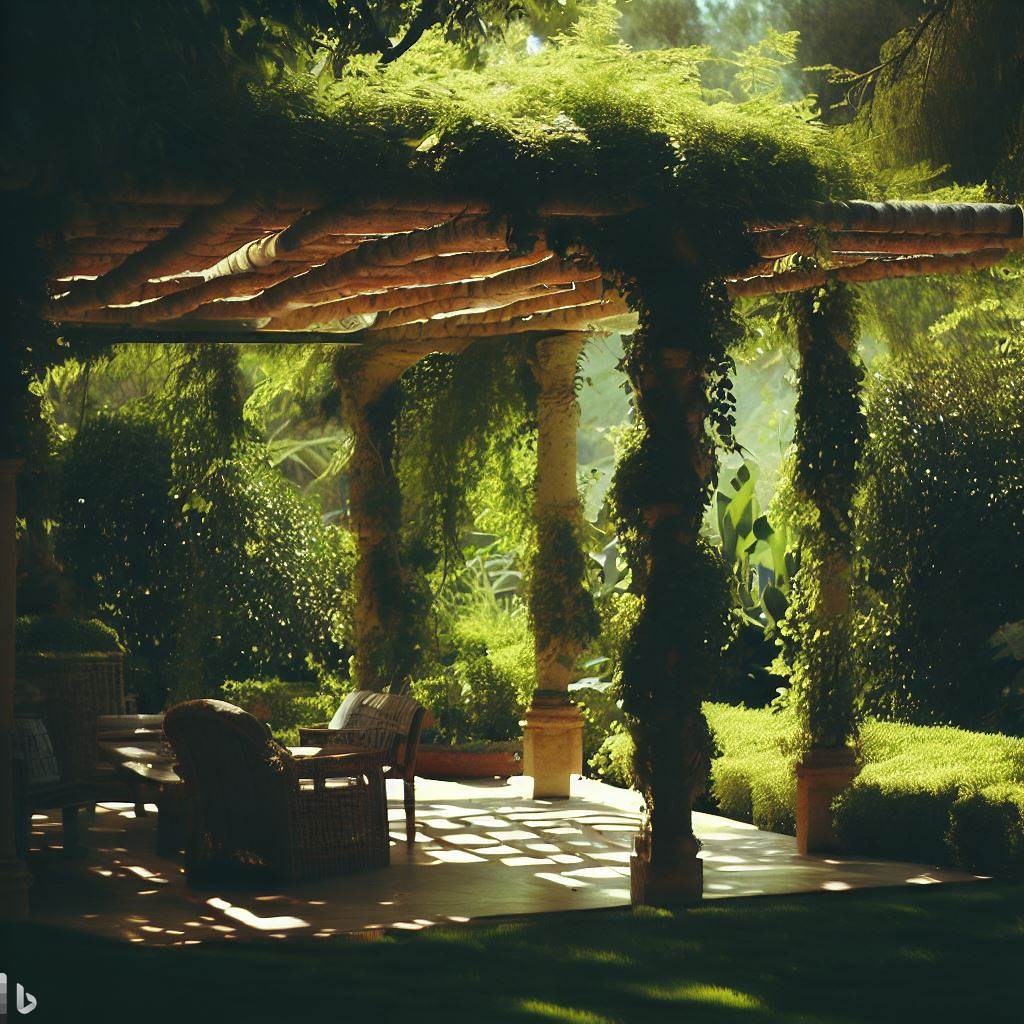
Professional Installation vs. DIY
While opting for professional installation may seem like the easier choice, there are benefits to taking on the project yourself. DIY allows for complete freedom and control over the design and execution of your pergola. Plus, it can be a rewarding experience that saves you money.
However, before diving into a DIY project, it’s important to assess your skills and capabilities. Building a pergola requires some level of expertise in carpentry and construction. If you don’t have the necessary knowledge or tools, hiring professionals is the safer option.
Professional installers bring their experience and expertise to ensure that your pergola is structurally sound and meets all safety standards. They also provide valuable guidance throughout the process, from choosing materials to optimizing the design for your specific space.
Whatever the case it’s important to consider both options carefully before making a decision that suits your needs best.
Conclusion
One thing has been clear so far: when it comes to choosing the right support for your pergola, there are several factors to consider. First and foremost, you need to carefully select the materials for your supports based on durability and strength.
Additionally, you must take into account the size and shape of the supports, as well as their height and placement. Anchoring and stability are crucial for ensuring the safety of your structure. Design and aesthetics should also be considered to enhance the overall appeal of your pergola.
Lastly, don’t forget about maintenance, longevity, cost considerations, and whether to hire professionals or opt for a DIY approach. By taking all these factors into consideration, you can ensure that your pergola will stand strong and beautiful for years to come.
FAQs On Large Posts For Pergola
Q: How do I choose the right support for my pergola?
A: When choosing the right support for your pergola, one important factor to consider is the size and weight of the structure. You want to make sure the support beams can adequately handle the load.
Q: What is the purpose of a pergola beam?
A: A pergola beam is an essential component of the structure as it provides support and helps distribute the weight of the pergola evenly.
Q: Can I build a pergola without a kit?
A: Yes, you can definitely build a pergola without a kit. However, using a pergola kit can make the process easier and more efficient, especially if you are not experienced in construction.
Q: How far apart should I dig the holes for the pergola posts?
A: The spacing for digging the holes for pergola posts depends on the size of the pergola and the code requirements in your area. Generally, a spacing of around 8 to 10 feet is common.
Q: How deep should I dig the holes for the pergola posts?
A: The depth of the holes for the pergola posts will depend on various factors like the size of the pergola, soil conditions, and local building codes. In general, a depth of at least 2 feet is recommended.
Q: Should I bury the pergola posts?
A: Whether or not you bury the pergola posts is a personal preference. Burying the posts can provide added stability, but it may not be necessary if the posts are secured properly in other ways.
Q: How long should the pergola beam be?
A: The length of the pergola beam will depend on the size of the pergola and the span it needs to cover. It is important to choose a beam that is long enough to provide adequate support.
Q: How do I attach the pergola posts to the footings?
A: To attach the pergola posts to the footings, you can use hardware specifically designed for this purpose. Be sure to follow the manufacturer’s instructions for proper installation.
Q: Do I need to notch the pergola posts?
A: Notching the pergola posts can provide additional support, especially if you are building a larger pergola. However, it is not always necessary and depends on the design and style of pergola you choose to use.
Q: How far apart should the support beams be for my pergola?
A: The spacing of the support beams for your pergola will depend on the size and dimensions of the structure. Generally, a spacing of 16 to 20 feet is common for larger pergolas.
